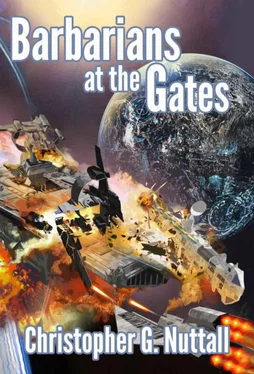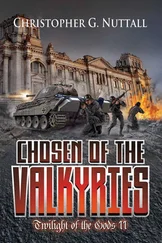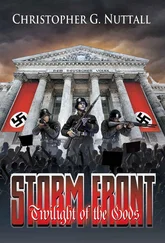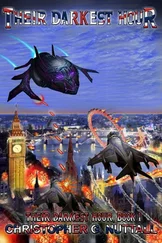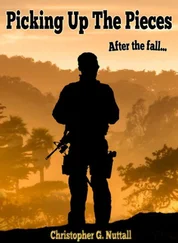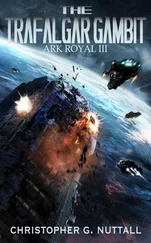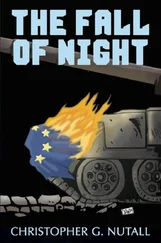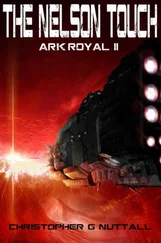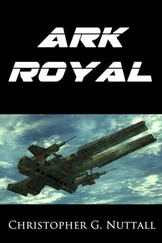It was one of the reasons why the Outsiders were so dangerous. The Federation made navigational data free for all, but the Outsiders had never shared any of their data with the Federation. And with the Survey Service practically moribund, there was little hope of updating charts, let alone placing navigational buoys near new Asimov Points.
As soon as the battle ended, Marius ordered his ships to rearm from the fleet train before resuming the advance. He’d lost twenty-seven ships in the battle and seventeen more had been damaged, some quite seriously. The mobile repair yards would do what they could before the damaged ships started to limp home (or, if the ship was too badly damaged, hid in the captured system until the end of the war). He was gratified—and somewhat amused—to discover that Captain Garibaldi’s luck hadn’t deserted him. Midway had been hit hard, but her shields had held and she’d barely been scratched.
“Sir, Mohammad and Argus report that they’re ready to rejoin their squadrons,” Raistlin said as the hours wore on. “ Harrington’s captain insists that his ship is also battle-ready, but the yard dogs disagree; they want more time.”
“They always want more time,” Marius commented. “Inform Captain Weber that if he trusts his ship is in fighting trim, he may rejoin the squadron. If not, assign him to Commodore Seiko’s command and Harrington can add her fire to her squadron.”
He smiled at the thought. Commodore Seiko commanded the covering force that would escort any damaged warships back to safe harbor. It wasn’t regarded as a prestigious position, but it was a vitally important role. She’d find a superdreadnaught, even a damaged one, very helpful. If nothing else, Harrington could tow some of the cripples home.
“Aye, sir,” Raistlin said.
“As soon as we are ready, the Grand Fleet is to advance,” Marius ordered. They’d be advancing blind, again, and this time the enemy would have to know they were coming. If the fortresses hadn’t screamed for help and fired off message drones, he’d be astonished. “We’re going to take them at a run.”
He ran through it again in his head. Assuming that a message had been sent as soon as the recon drones had transited the Asimov Point, it would be nearly two days before Admiral Justinian heard about the advance. If Marius made the further assumption that Admiral Justinian would react at once, it would mean roughly two weeks—perhaps twenty days—before Justinian got a blocking force into position. It would be longer if Justinian had kept most of his fleet facing Boskone or defending Marx, but Marius didn’t dare count on it. The further he got up the chain towards Jefferson, the better.
And what if there was something he’d missed?
He shook his head slowly. His doubts—and doubts were a natural part of such an ambitious operation—weren’t important. All that mattered now was speed—and victory.
Sun Tzu, thousands of years ago, laid down the basic rules that we still follow today. When an enemy is weak, advance; when strong, fall back. We think of terrain as being Asimov Points, planets and stars, instead of the wily Chinese General’s land and seas, but the principles remain the same.
-Observations on Military Tactics, 3500 A.D.
Jefferson/Lombardi System, 4097
“Shit! They came through the back door. Damn them.”
Caitlin had rarely seen Admiral Justinian so rattled, but the news was shocking enough to worry the strongest of men.
Her commander turned and studied the display. The Federation Navy was—presumably—advancing as fast as possible up the chain towards Jefferson. It would have to punch its way through four Asimov Points to reach the nexus star, but none of them were heavily defended. They certainly wouldn’t be taken by surprise, not once the warning had been passed up the chain, yet it wouldn’t really matter. The Federation Navy wouldn’t have launched such an offensive unless they believed that they possessed a crushing superiority.
“The report was vague as to their strength,” she said, scanning the final sensor readings the destroyer Danton had taken before she’d fled back to Jefferson. The ship’s captain had nearly burned out his drives trying to reach Jefferson before it was too late. The hell of it was that it might be futile anyway. “We only saw forty-odd superdreadnaughts.”
“They’ll have more,” Justinian said, dismissing her optimistic projection. “We need to stop them before they break into Jefferson.”
He was right, she knew. Local commanders would do what they could to parse—and then delay—the full strength of the attacking force before it reached Jefferson, but Caitlin knew that they couldn’t do much. Admiral Drake would hardly repeat the mistakes of the Retribution Force.
Jefferson and its nine Asimov Points served as the nexus for Admiral Justinian’s empire. If the Federation Navy contested the system—let alone captured it—they would break the chains holding the empire together. Some of Justinian’s more reluctant allies would switch sides, his junior commanders might turn into warlords on their own…it would be the end.
They couldn’t allow the Federation Navy into Jefferson.
Admiral Justinian considered the overall picture, thoughtfully. “At least we have the combined fleet in a position to make transit back to Jefferson fairly quickly,” he said.
Caitlin nodded. She’d already sent orders along the ICN to alert the fleet to be prepared to move.
“We bring them back into Jefferson and then advance along the Chain to”—he studied the display, apparently trying to gauge how fast the Federation Navy could move—”Lombardi, I think. I doubt we’ll get much further unless Admiral Drake feels like resting on his laurels.”
“He won’t,” Caitlin said. “He had the imagination to blaze right through Bester…”
“True,” Admiral Justinian agreed. “If we get the fleet into place before the enemy enters the system, we’ll set up a defense on the Asimov Point and stop them cold. If not, we will have to contest the system and force them to assault the other Asimov Point.”
He keyed his console. “In the meantime, I want tugs moving fortresses from the other Asimov Points to the terminus of the Sphinx Chain,” he added. “Even if the fleet fails, we can try to hold the Jefferson System.”
Caitlin considered it.
“It will take weeks to move enough fortresses over to the Asimov Point to make a difference,” she told him. Towing a multimillion ton fortress wasn’t an easy task at the best of times. “We could hold the fleet in Jefferson itself and force them to come to us.”
“Maybe, but we might lose control of the outer system,” Justinian pointed out. “And there is another concern.”
His hands danced over the console. “As you can see, a hostile attacker who takes Lombardi will be able to cross interstellar space and reach Harmony,” he explained. “There’s only forty light years between the two stars and if they secure Lombardi, they don’t need to attack Jefferson at all.”
“Unless they want to link up with the forces defending Boskone,” Caitlin reminded him. “If they opened up the Asimov Point chain for shipping, they could reinforce their fleet remarkably quickly…”
“I know,” Admiral Justinian said. “There’s little else that we can do.”
Caitlin felt a flicker of sympathy, for he was facing the same dilemma he’d inflicted on the Federation. He had too many places to defend, and far too few ships and fortresses to cover them all. Most of his mobile firepower was badly out of position and it would take weeks to concentrate it to reinforce his reserves. A loss now could cost him the entire war.
Читать дальше
